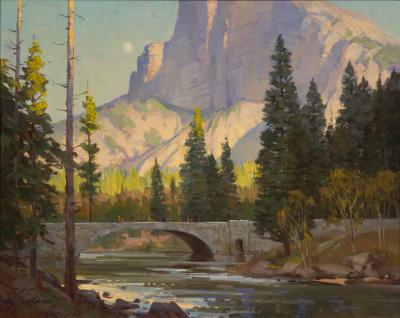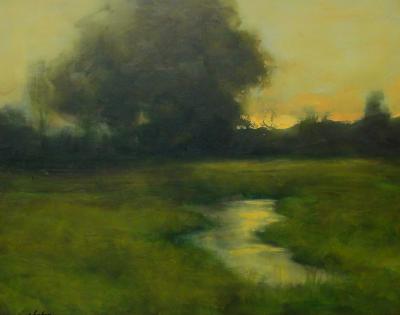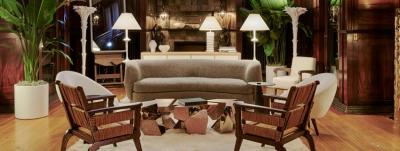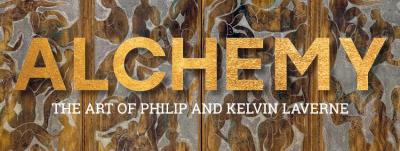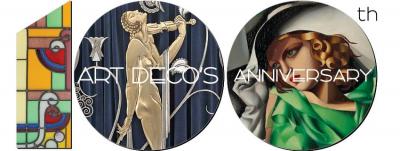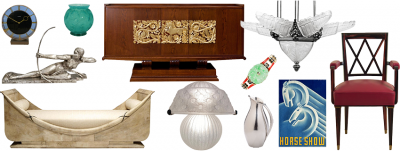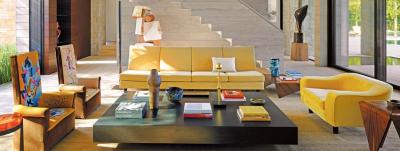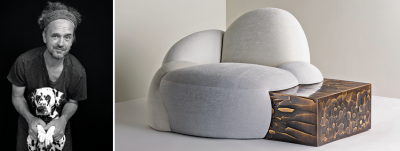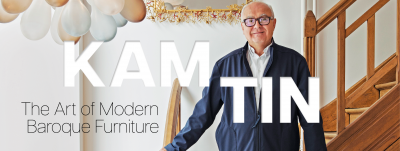The Artist's Garden: American Impressionism and the Garden Movement, 1887—1920
This archive article was originally published in the Anniversary 2015 issue of Antiques & Fine Art magazine.
- Fig. 1: Maxfield Parrish (1870–1966) / Tiffany Studios, The Dream Garden, designed in 1914, unveiled in 1916. Favrile glass mosaic, 180 x 588 inches. Pennsylvania Academy of the Fine Arts, Philadelphia; Partial bequest of John W. Merriam; partial purchase with funds provided by a grant from The Pew Charitable Trusts; partial gift of Bryn Mawr College, The University of the Arts, and The Trustees of the University of Pennsylvania (2001.15).
The national garden movement and, in particular, artists’ interest in gardens, has deep roots in Philadelphia, beginning with William Penn’s founding of his green and pleasant town in the seventeenth century and John Bartram’s establishing his botanical garden in 1728. In the early nineteenth century, artist Charles Wilson Peale retired to the cultivation of his garden at Belfield, and the Pennsylvania Horticultural Society was founded (in 1827), two years later hosting its first flower show. Interest gained momentum with the Colonial Revival movement, itself an outcome of Philadelphia’s 1876 Centennial Exhibition, and continued into the twentieth century.1 In her popular 1901 Colonial Revival-inspired publication Old Time Gardens, Alice Morse Earle wrote of Philadelphia: “There floriculture reached by the time of the Revolution a very high point, and many exquisite gardens bore ample testimony to the ‘pride of life,’ as well as to the good taste and love of flowers of Philadelphia Friends.” 2
Horticultural obsession also permeated the Philadelphia art scene. One of the most iconic conjunctions of art and the garden is the commissioning from Maxfield Parrish and Tiffany Studios of the fabulous Dream Garden (1913–1915, installed 1916) (Fig. 1) for the Curtis Building. The work was commissioned by Edward W. Bok (1863–1930), the head of Curtis Publishing, the influential publisher of Ladies Home Journal for the company’s new headquarters in Philadelphia. The mural was made by two artists whose gardens were of central importance in their oeuvre. Maxfield Parrish’s home in the Cornish Colony of New Hampshire, famous for its gardens, was an inspiration for the mural. Tiffany’s garden at his estate in Long Island was not only an inspiration for his stained glass but for other artists as well.
The exhibition, The Artist’s Garden, at the Pennsylvania Academy of the Fine Arts, tells the intertwining stories of American artists, Impressionism, and the growing popularity of gardening as a middle-class leisure pursuit at the turn of the twentieth century (Fig. 2). The period of focus, the Progressive Era—1890s–1920s—is recognized as one of intense political, social, and artistic change in the United States.3 The decades that the exhibition covers saw an upsurge in nationalist feeling inspired by the afterlife of the Centennial Exhibition (1876), anxieties about mass European immigration, agitation for universal women’s suffrage, the advent of World War I and concomitant “war gardens,” the emergence of a robust middle class eager to make their mark on the American landscape, and the arrival of French Impressionist painting and principles in American galleries and studios.
The Garden Movement in the United States was a product of, and impetus for, many of these changes. This movement was driven by American suburban lifestyles at the turn of the century that were linked to the development of railroad suburbs, an interest in the creation of Garden Cities and public parks, and the influence of Arts and Crafts principles first articulated in late nineteenth-century England. Born in the nostalgic atmosphere of the Colonial Revival, which sought to revive elements of architectural style, garden design, and interior design of American colonial architecture, the Garden Movement represents a national and middle-class enthusiasm for cultivating gardens that were intimate and distinctly American (Fig. 3).4
The increasing professionalization of art in the United States at the same time meant that artists, too, were members of the aspiring middle classes that pioneered the garden movement (Fig. 4). Many of these artists had traveled to Europe, especially France, where they were exposed to the modernist style of Impressionism. Lingering in the French countryside and in the public parks of Paris, they experimented with Impressionist principles of plein air painting, the study of light, and the application of unmodulated color in quick brushstrokes. The first exhibition of French Impressionist art in the United States opened at the Durand-Ruel gallery in New York City in 1886. In the United States, as in Europe, the concerns and techniques of Impressionism made the outdoor garden a natural subject of art. By 1887, American artists were traveling to Claude Monet’s famous garden at Giverny to study with the master Impressionist (Fig. 5).
Whether or not American artists wholly subscribed stylistically to European Impressionism, they were forced to grapple with the sea change it brought to modern art and culture. While artists such as John Breck, Frederick Carl Frieseke, and Theodore Robinson (Fig. 6) cast themselves in the stylistic mold of French Impressionists, other painters, including Hugh Henry Breckenridge, Maria Oakey Dewing, and Childe Hassam (Figs. 7, 8) filtered its principles through their own vision to create a distinctive style. Dewing’s painterly style cannot be described as impressionist, but her insistence on the study and painting of flowers en plein air was a product of the impact of French Impressionism on American painters. Even outside the art world, the language of Impressionism permeated American society, informing how people talked about the speed of modern life, the cadence of their poetry, and the spectacle of their gardens. Even a traditionally academic painter like Anna Lea Merritt (Fig. 9) espoused an Impressionist aesthetic when it came to her description of her gardening activities in An Artist’s Garden: Tended, Painted, Described (1908).
Many of the artists included in the exhibition had complicated relationships with Impressionism. Artists such as John Henry Twachtman (Fig. 10) and Thomas Wilmer Dewing might be more correctly described as Tonalists; and though Henry Hugh Breckenridge and Philip Leslie Hale (Fig. 11) experimented with Impressionism, they also dabbled in abstraction and academic painting; photographer Thomas Shields Clarke (Fig. 12) and illustrator Violet Oakley (Fig. 13) cannot be described as Impressionists either. But all were united by their deep artistic engagement with their gardens and their obsessive use of certain themes, flowers, and compositions. Many of these artists were commuters who taught in the city but lived along the lines of suburban train or trolley car suburbs: Breckenridge and Oakley in Philadelphia, Twachtman in New York City, and the Hales in Boston. All belonged to the class of educated urban professionals that was the intended audience for the mushrooming garden publication industry and culture.
Like Merritt, many artists also wrote about gardens, and numerous articles from the period document artists’ thoughts on how to paint flowers, and why they considered it valuable to paint in the garden. Jane Peterson, who began painting in Louis Comfort Tiffany’s garden on Long Island in 1910, talked about her “great and absorbing passion” for flowers in an article published in The Garden Magazine in 1922, describing flowers as the “most elusive art of a nation.” She loved painting flowers, she said, for their “prismatic hues of the rainbow” and because they were “all that is delicate; all that is lurid, brilliant, bizarre.” 6 In Peterson’s painting Spring Bouquet (ca. 1912) (Fig. 14), the color palette she uses is brilliant and almost lurid—especially in the orange of the poppies that is echoed in the bright orange of the woman’s headdress. The steep tilted perspective of postimpressionism and the inherent sense of pattern in the composition of the background are complemented by a foreground of individualized specimens which can be identified by genus, such as bearded iris, lilies, and poppies. The flowers she chooses are as fashionable as the up-to-date gown and headdress that the central figure wears. She also shows her central figure reaching out to touch the flowers in the garden—imparting a sense of the tactility of flowers to the viewer. The gesture may have been a sign of rebellion on Peterson’s part, for she wrote that her mother always forbade her to touch the flowers in her garden.
In a 1909 article in Palette and Bench, a magazine for art students, Charles Curran wrote about fellow artists Willard L. Metcalf and Robert W. Vonnoh’s depictions of gardens and the “…harmony there is in Mr. Metcalf’s luxuriant garden of flowers…In looking at such a gorgeous mass of flowers in nature the eye would be so filled with the richness and profusion of forms that the precise form of no one particular flower would be noticed. It would detract greatly from the charm of such a picture if each flower were sharply drawn in detail….” 7 Curran encouraged students of painting to capture the “delightful general impression” of flowers, and reminded them that white flowers are not all white, nor purple. In Curran’s description of Metcalf’s “brisk, easy manner” as well as his use of color techniques we can see that in the case of Metcalf, at least, French Impressionist principles were being used in his paintings of gardens.
The Artist’s Garden: American Impressionism and the Garden Movement, 1887–1920 was on view at PAFA from February 13–May 24, 2015, before ot toured to Chrysler Museum of Art (June 16–September 6, 2015); Reynolda House Museum of American Art (October 1, 2015–January 3, 2016); The Huntington Library, Art Collections and Botanical Gardens (January 23–May 9, 2016); and the Florence Griswold Museum (June 3–September 18, 2016). An illustrated catalogue published in conjunction with the University of Pennsylvania Press is available at www.pafa.org/Shop/.
Anna O. Marley is curator of historical American art at the Pennsylvania Academy of the Fine Arts.
This article was originally published in the Anniversary 2015 issue of Antiques & Fine Art magazine, a digitized version of which is available on afamag.com. Antiques & Fine Art, AFAmag, AFAnews, and AFA Publishing are affiliated with InCollect.com.
2. Alice Morse Earle, Old-Time Gardens Newly Set Forth (New York: The MacMillan Company, 1901), 12.
3. For more on the progressive era see Rebecca Edwards, New Spirits: Americans in the Gilded Age: 1865–1905, 2nd edition. (Oxford, UK: Oxford University Press, 2010.);
T. J. Jackson Lears, No Place of Grace: Antimodernism and the Transformation of American Culture 1880–1920 (New York: Pantheon Books, 1981); T.J. Jackson Lears, Rebirth of a Nation, the Making of Modern America, 1877–1920 (New York: Harper Collins, 2009).
4. For excellent essays on the Colonial Revival Movement see Richard Guy Wilson, Shaun Eyring, and Kenny Marotta eds., Re-creating the American past : Essays on the Colonial Revival (Charlottesville: University of Virginia Press, 2006.)
6. Jane Peterson, “Why I Paint Flowers,” The Garden Magazine (September 1922).
7. Charles C. Curran, “Class in Oil Painting,” Palette and Bench, I, no. 10 (July 1909): 216.























